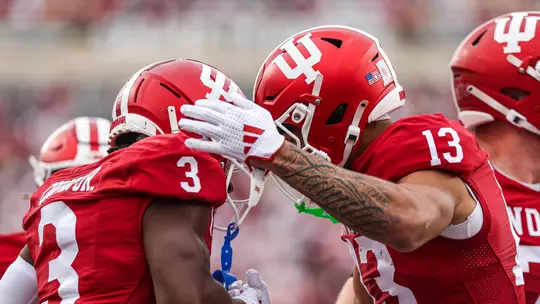
NOTEBOOK: Hoosiers Have Something to Prove Friday Night
Pete DiPrimio | IUHoosiers.com
BLOOMINGTON, Ind. – There has never been an Indiana football game like this -- a playoff opportunity, a chance to win a national title, a Friday night trip to Notre Dame (11-1) where the Hoosiers (11-1) have played just once in the last 66 years and haven’t won since 1898.
Does that mean head coach Curt Cignetti will finally -- finally -- break from his next-game-is-the-biggest-game routine to ensure IU is ready for the historic challenge?
Not a chance.
“To me and our guys,” Cignetti said, “it’s just another game. You prepare for this one like you prepare for all of them.”
And then …
“Our players are going to be excited to play and excited to prove something.”
And finally …
“It’s just football. The game will be won or lost between the white lines. I want our players to go out there, fly around, have a little swag, and play the way we can play.”
What Cignetti doesn’t want is a repeat of the 38-15 November Ohio State defeat, when punting mistakes cost IU 14 points and pass protection was a big problem. Quarterback Kurtis Rourke was sacked five times and pressured relentlessly.
“I don't think anyone was happy with the way we came out of Ohio State,” he said. “We didn't give ourselves a chance to be successful, giving up 14 points on the punt team and then having some communication breakdowns on pass pro. We didn't give ourselves a chance to play offense.
“I think our guys have learned from that too and we'll be better in a hostile environment than we were that day.”
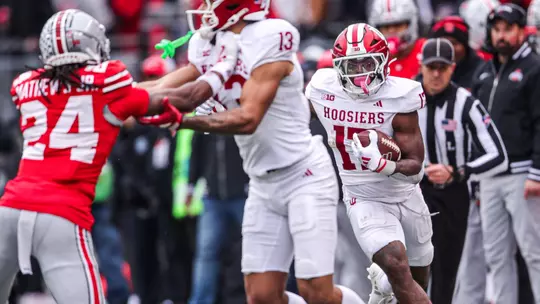
IU’s offensive success – 43.3 points, 173.6 rushing yards, and 265.2 passing yards per game – comes from multiple reasons, but don’t overlook perimeter blocking in general, wide receiver blocking in particular. Few teams do it as well.
Offensive coordinator Mike Shanahan said it’s been emphasized since “day one” to the receiver group.
“That starts with Coach Cignetti and myself demanding it from those guys,” he said. “I've put it like this to them. There are about 70 plays in a game. Usually, if you get five to 10 balls thrown your way, you feel pretty good about it. That still leaves about 60 other plays in the game where you may not be getting the ball, so how are you making an impact without the ball in your hands?”
Shanahan said he makes sure to praise running backs when they pick up a blitz or tight ends when they make key perimeter blocks that spring a receiver for a big gain.
“It’s things like that where their teammates are busting their butts to help them get a catch or make a big play, so we should be doing the same thing for them.”
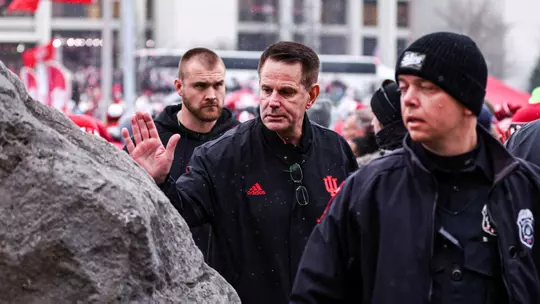
Cignetti calls himself a “film junkie,” which doesn’t mean he’s watching movie masterpieces such as “The Godfather,” “Citizen Kane” or, for those with a more sports inclination, “Rocky.”
Cignetti pours over opponent game film, and he’s had nearly two weeks to analyze the Notre Dame offense and defense.
“In my free time, I’d just as soon be watching tape than anything else other that sitting in my recliner,” he said with a smile while referring to his decades-old favorite home chair.
“You’re always trying to gain the edge in this business because all these coaches can coach, all these teams are good. The margin for error is very slim every game, and you’ve got to always work toward finding the edge.”
Cignetti has inspired quarterback Kurtis Rourke, who has taken his film watching to a new level during his one Hoosier season after transferring from Ohio University. He earned All-Big Ten recognition after throwing for 27 touchdowns and 2,827 yards while completing 70.4 percent of his passes. He only threw four interceptions.
“I’ve always tried to improve and work on things, and film was something I learned to watch,” Rourke said. “You can watch it and not get a lot from it.
“I know how much Coach Cig watches film. It shows how much he cares. It makes you want to watch even more film.
“I wouldn’t say he’s changed the way I thought about watching film. I knew it was good preparation. We all recognize how hard he works. It makes us want to work that hard, as well.”
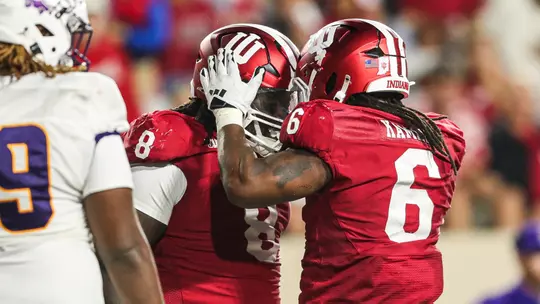
Notre Dame quarterback Riley Leonard, a Duke transfer, adds an extra element to the Irish’s rushing attack. At 6-4 and 216 pounds, he’s second on the team with 721 yards and 14 touchdowns behind tailback Jeremiyah Love’s 949 yards and 15 TDs. Jadarian Price adds 651 yards and seven touchdowns.
“They run the quarterback quite a bit,” Cignetti said, “and (Leonard is) an excellent player. I've been watching him for a couple years, studying the Duke offense, when he was at Duke. He's a competitor, and he throws the ball well. He's got good movement skills, good size.
“When you play Notre Dame offensively, it starts with the run game, and the quarterback is a big part of the run game, not only on the designed quarterback runs, but when he drops back and he's in the pocket and escapes the pocket and his ability to create plays with his arm and his legs.”
IU and defensive coordinator Bryant Haines have had nearly two weeks to prepare.
“Post-snaps nothing really changes too much,” he said. “Our reads are our reads. Our keys are our keys. It all fits into that bucket.
“Nothing can fully help with a plus-one run game like a quarterback that's simply going to run with a lead blocking running back. There's only so many things you can do to account for that. You’ve got to use all 11 (defensive players).
“I can work through that with what (defensive plays) I call, but in terms of pre-snap, we have our reads, we have our fits, get off blocks, make plays, attack.”
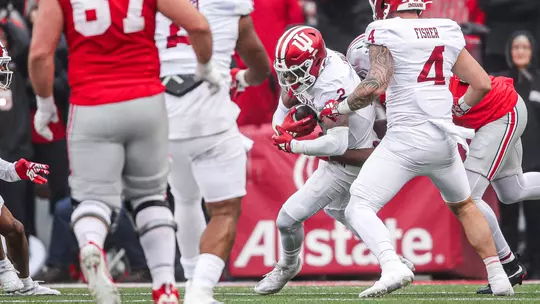
Both teams thrive on forcing turnovers. Notre Dame is plus-16 in that category. IU is plus-15. The Irish have forced 25 fumbles and recovered 11. They’ve also intercepted 17 passes.
The Hoosiers have intercepted 14 passes, forced 15 fumbles and recovered nine.
“Ball security for us and for them is going to be really important,” Cignetti says. “It’s winning the turnover battle.”
Beyond that, Notre Dame has blocked three punts and pressured teams into several bad snaps. They’ve also had a couple of fake punts.
Cignetti is very aware.
“Those are game changers,” he says. “They use their punt and punt returns as weapons. We’ve got to be right on point there. We’re going to need a good special teams effort.”
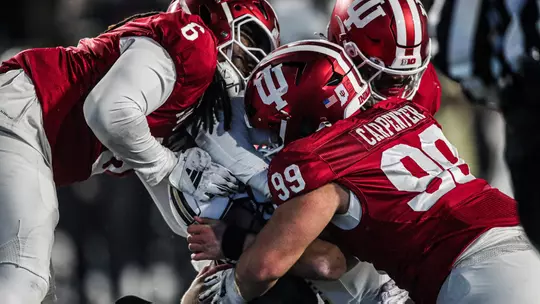
Passive is not part of the defensive approach for Cignetti or Haines. When in doubt, attack. When not in doubt, still attack. This “Fast, Physical, Relentless” approach has thrived for both coaches, first at James Madison, now at Indiana.
“I've always felt like that's what I would want my defense to be,” Haines said. “I've been with Coach Cignetti for a long time. I started as the defensive line coach, I wasn’t calling the defense, but what did I want my defensive line play to be? I wanted them to be fast, violent, physical, and northbound. I wanted to play in (the opposing team’s) backfield. I took that when I was a linebacker coach. I wanted to be downhill aggressive, slipping blocks, getting vertical, playing in (opponents’) own backyards.
“Now that I'm a defensive coordinator, I'm doing all of it. I want the same thing. That's never changed. I don't know where the (Fast, Physical, Relentless) phrase came from, but that's who we both are from a personality standpoint. We want to attack.”
Come Friday night, wanting will become doing. The goal is clear -- beat Notre Dame for just the sixth time in 30 meetings and advance to a showdown with Georgia (11-2) in the Jan. 1 Sugar Bowl in New Orleans.
